Are you a seafood enthusiast? If your favorite part of going out to eat is ordering a beautifully seared tuna ahi tuna steak, it might be time you learn how to cook ahi tuna yourself. Once you’ve mastered how to cook ahi tuna on your own, you can make any night a special occasion!
Below, you’ll discover everything you need to know before heating your stovetop, including what ahi tuna is, how to cut fresh ahi tuna, and how to cook it to perfection. Keep reading to get one step closer to having a gourmet ahi tuna steak tonight.
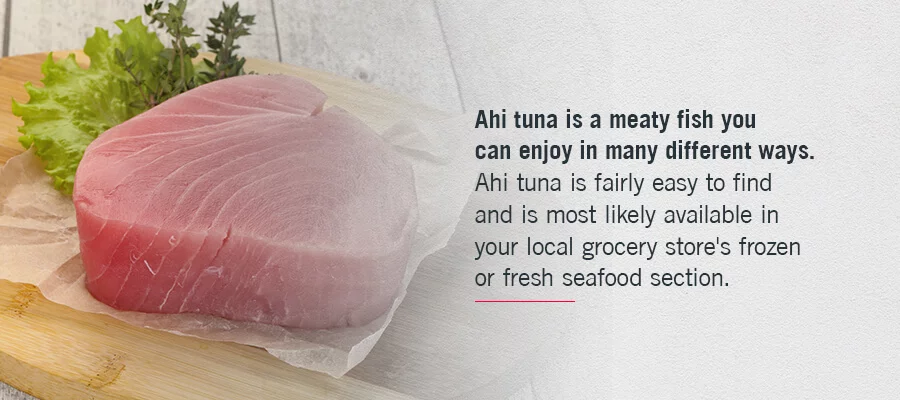
Table of Contents
What Is Ahi Tuna?
Why Cook Ahi Tuna
How to Cut Fresh Tuna
How to Cook Tuna Steak
Use SAN-J Sauces to Season Your Ahi Tuna
What Is Ahi Tuna?
Ahi tuna is a meaty fish you can enjoy in many different ways. Most cuts of ahi tuna are less expensive than bluefin tuna, which has a similar texture and flavor profile to ahi tuna. Ahi tuna is also fairly easy to find and is most likely available in your local grocery store’s frozen or fresh seafood section.
As a type of tuna, ahi tuna is divided further into two separate species — yellowfin and bigeye. While bigeye tuna is known for its rich, buttery taste and smooth texture, yellowfin tuna is recognized for its milder flavor and firmer texture. These characteristics make bigeye tuna steaks perfect for grilling and thin yellowfin tuna slices popular for sashimi.
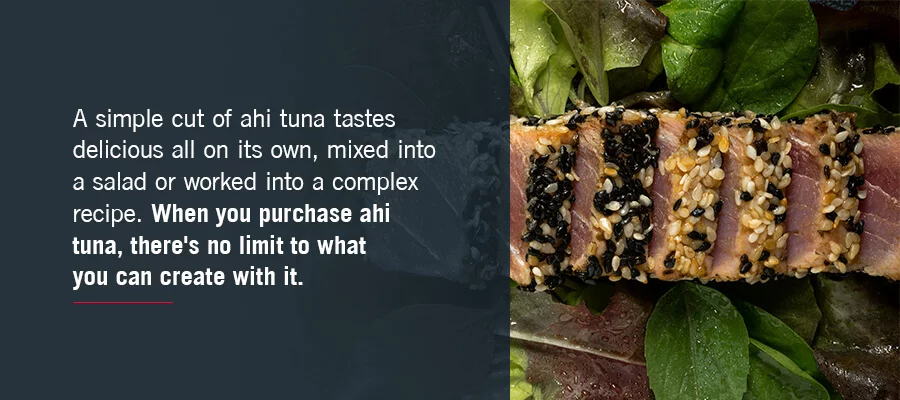
Why Cook Ahi Tuna
Now that you know what ahi tuna is and where to find it, you might be wondering why you should buy it. Ahi tuna is a great fish to have on hand because it’s tasty and versatile. A simple cut of ahi tuna tastes delicious all on its own, mixed into a salad or worked into a complex recipe. When you purchase ahi tuna, there’s no limit to what you can create with it.
Here are some ahi tuna recipe suggestions to get your creative culinary juices flowing:
- Poke bowl: Ahi Tuna Poke bowls are all the rage right now. These delightful poke bowls typically consist of rice or another grain base, diced raw fish and various fresh toppings like tomato slices, mango chunks, shredded carrots, edamame and seaweed salad. The ingredients are usually doused in a delicious sauce and garnished with something crunchy like sesame seeds or nori.
- Steak-style: Ahi tuna is a hearty enough meat that you can grill it up just as you would a steak. The beauty of ahi tuna is its tender cut, so make sure you don’t overcook your tuna steak, leaving it dry and tough.
- Fish tacos: You can make some fantastic fish tacos with ahi tuna. The tastes of ahi tuna pair well with many traditional taco toppings, such as cilantro, red onion, avocado and salsa. Ahi tuna goes exceptionally well with fruit-based salsas like a tropical pineapple salsa.
- Salad: Thin slices of ahi tuna steaks can quickly become the star of any salad. The mild fish goes well with many mainstay salad ingredients, including most fresh veggies, dried fruits, nuts, seeds and dressings. Placing pieces of ahi tuna on top of your spinach, arugula or other salad greens is a great way to add some protein to your meal.
- Citrus fruits: If you want to keep your tuna recipe easy or just start with a small appetizer, you can simply serve slivers of ahi tuna with sliced citrus fruits, such as grapefruit, blood oranges and mandarin oranges, along with a light vinegarette. The sharper flavors of citrus fruits contrast nicely with the mild taste of tuna.
- Roasted veggies: If citrus fruits aren’t in season, you can enjoy your ahi tuna alongside roasted vegetables. In particular, a cut of ahi tuna tastes delicious with roasted asparagus, green beans, sweet potato, cauliflower or beets.
- Tuna burger: Jazz up your traditional burger night and keep your taste buds guessing by swapping your usual beef patty for ahi tuna. This fresh change will lighten up your meal while satisfying your burger craving.
Experimentation is key when trying new foods, so feel free to explore different ahi tuna dishes when you’re on your way to finding your favorite.
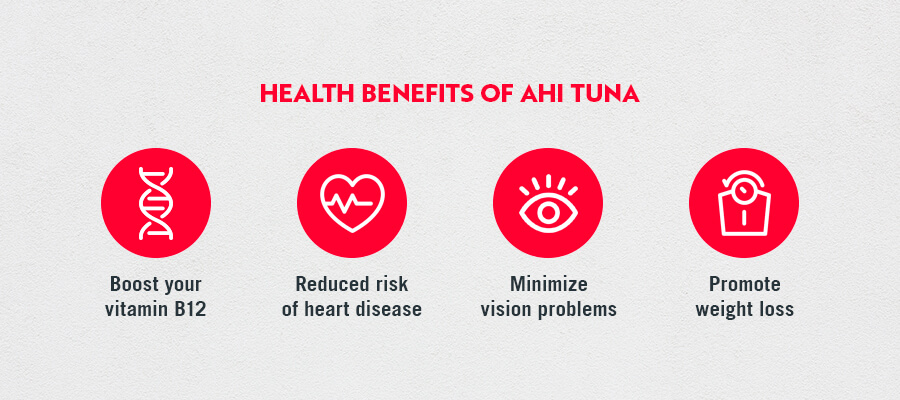
Health Benefits of Ahi Tuna
Along with being delicious, ahi tuna is nutritious. In fact, working ahi tuna into your regular diet comes with a range of health benefits. Check out five health advantages of eating tuna below.
- Boost your vitamin B12: Ahi tuna is an excellent source of vitamin B12, which is a key vitamin for making DNA. In addition, vitamin B12 helps your body form new red blood cells and prevents you from developing anemia.
- Reduced risk of heart disease: Tuna has high levels of omega-3 fatty acids, which help decrease low-density lipoprotein (LDL) cholesterol and omega-6 fatty acids that can build up inside the heart’s arteries. Getting more omega-3 is linked to lower rates of cardiovascular disease, including heart attacks.
- Minimize vision problems: Tuna’s omega-3 fatty acids also appear to positively impact eye health. Specifically, omega-3s contribute to the retina’s overall health, so tuna is a top food many optometrists recommend.
- Promote weight loss: Ahi tuna is a lean meat, which means it’s relatively high in protein while being low in calories. The combination of these qualities means ahi tuna keeps you full longer and prevents you from eating more. Swapping red meat for lean fishes like tuna may help you lose weight faster than you would otherwise, depending on your other health habits.
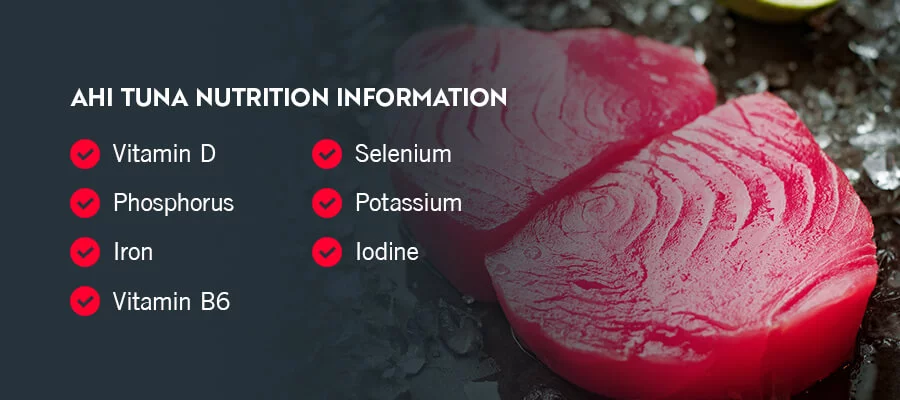
Ahi Tuna Nutrition Information
In addition to the health advantages listed above, ahi tuna is full of other essential vitamins and minerals. Here’s a breakdown of the main nutrients found in ahi tuna:
- Vitamin D: Tuna is one of the best dietary sources of vitamin D, making it an excellent food for promoting bone health, ensuring optimal growth and development for children and strengthening the immune system against sicknesses.
- Phosphorus: Phosphorus is another bone-friendly nutrient you can find in ahi tuna. Phosphorus is essential to bone health because your body uses the mineral to generate new bone tissue.
- Iron: Iron is crucial for transporting oxygen and carbon dioxide. Not getting enough of this vital mineral may result in anemia.
- Vitamin B6: This B vitamin is another crucial nutrient for fending off anemia. Getting enough vitamin B6 in your diet is critical for helping your body properly process fats, sugars and protein. This vitamin also aids in the growth and development of your brain, nerves and skin.
- Selenium: As your body digests the ample amount of protein found in ahi tuna, it gives rise to individual amino acids used to produce proteins needed for tissue strength, along with hormones and enzymes vital for cell function. Ahi tuna’s high level of selenium helps activate many of these enzymes, which can help your body control new cell growth and maintain proper blood vessel function.
- Potassium: The potassium found in ahi tuna supports nerve and brain function. Potassium is an electrolyte that assists in nerve communication by helping your nerves to conduct electricity.
- Iodine: Iodine is a chemical element the body needs for making hormones but can’t produce on its own. You can get some iodine from eating tuna, which will help your thyroid function smoothly.
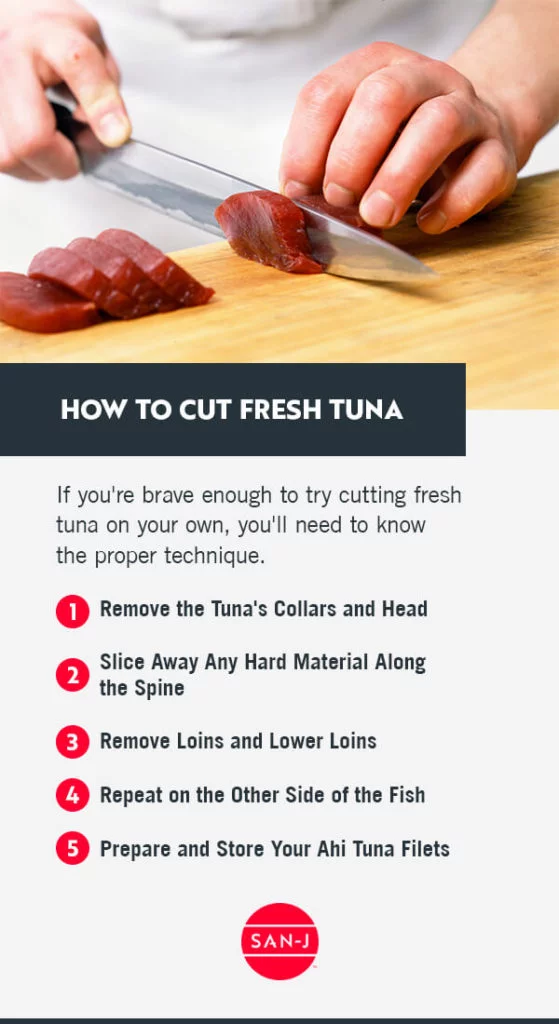
How to Cut Fresh Tuna
If you’re brave enough to try cutting fresh tuna on your own, you’ll need to know the proper technique. Once you’ve bought your beautiful ahi tuna fish, you can start prepping it for cooking. Even if you plan on enjoying your ahi tuna raw, you can still follow the five steps below to cut your ahi tuna like a certified sushi chef.
1. Remove the Tuna’s Collars and Head
Begin by laying the fish on its side with its belly facing you. Use the back of a sharp knife to feel for the hard, scaly material running along the lateral, spanning from the pectoral fin to the tail. Take the knife and start cutting the hard material away from the ahi tuna, beginning a little less than halfway up the tail and cutting toward the pectoral fin. Make sure you don’t cut into the fish, but lightly shave the scales away from the surface of the fish’s flesh while tugging on the pectoral fin.
After reaching the fin, you can start cutting into the tuna’s shoulder. Slice from the top of the head and around the collar in the direction of the belly. Once you’ve completed that cut, flip the ahi tuna over and repeat the same cut on the opposite side.
After cutting around the collar on the other side, you’ll be ready to cut through the fish’s spine. Hit the back of the knife with the palm of your hand to cut through the tuna’s soft bone. A light pull should be enough to detach the head from the rest of the fish. Then, you’ll be able to cut the collars free from the head.
2. Slice Away Any Hard Material Along the Spine
Once you’ve successfully removed the head and collars, lay your ahi tuna upright on its belly. Be extremely gentle while doing so to avoid applying more force than the fish’s own weight on its belly, which you can easily destroy with too much pressure.
Holding onto the ahi tuna by the dorsal fin, start to slice away the tough scale material running along the back of the fish. Just like you did with the lateral line material leading to the pectoral fins, pull slightly upward on the dorsal fin as you cut away the material. Keep cutting all the way to the head.
3. Remove Loins and Lower Loins
Now, you can lay the ahi tuna back down on its side and slice through the entire lateral line all the way to the bone. Cut the loin from the fish’s upper rib bones. Your knife should scrape the ribs — you’ll be able to feel the tip of the knife hit the spine. While gently pulling the loin toward you, sever anything still connecting the loin to the spine. Remove and reserve cold.
To get rid of the lower loins, turn the ahi tuna around so its tail is toward you. With a firm grip on your knife, cut the rib bones that secure the lower loin and belly onto the fish’s carcass. Remove the tail end of the lower loin by cutting slightly above the middle of the fish from its tail to its cavity opening.
4. Repeat on the Other Side of the Fish
Once you’ve removed the loin and belly, flip the ahi tuna over and repeat the process set out in step three.
5. Prepare and Store Your Ahi Tuna Filets
Now that you’ve removed the lower loin from the tuna, you can cut the fatty belly away. Trim away any rib bones remaining on the fish’s lower loin. You can either cut out the bloodline immediately or just before using the tuna.
Skin all your filets and reserve cold. Make sure you trim away any tough tail ends as well as soft front ends. To store your ahi tuna for a day, wrap it in sushi paper and place it on a tray in the fridge. For longer-term storage, wrap the ahi tuna in sushi paper, vacuum seal it and freeze the fish as cold as possible.
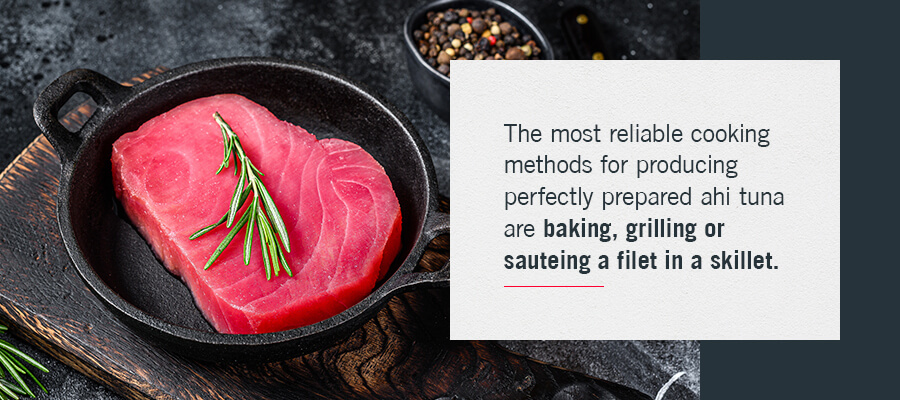
How to Cook AHI Tuna Steak
Now’s the time to start the cooking process. While ahi tuna can be a mouthwateringly tasty fish, how you cook it makes all the difference. When properly seared or served raw, ahi tuna tastes more tender, mild and oily. However, ahi tuna cooked medium can taste more like fishy cardboard.
The most reliable cooking methods for producing perfectly prepared ahi tuna are baking, grilling or sauteing a filet in a skillet. For the best results, you’ll want to season or marinade your ahi tuna before cooking and sear it on the stovetop. This section will go over everything from seasoning and searing your tuna steak to specific ahi tuna recipes.
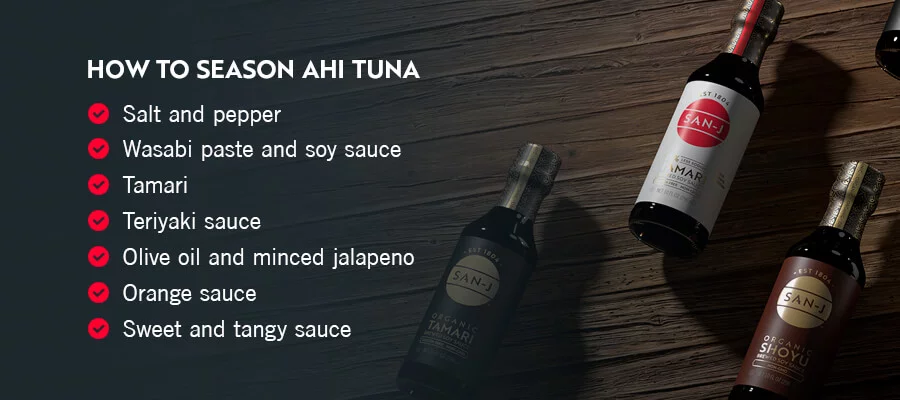
How to Season Ahi Tuna
Before tossing your tuna in the skillet, you need to know how to prepare your ahi tuna steaks. Make sure you marinate it and sprinkle it with your favorite seasonings. Seasoning your tuna steak beforehand will allow the ahi tuna to absorb more of the marinade’s flavors and make for a more delicious steak.
If you’re not sure what flavors to add to your ahi tuna, consider any of these tasty options:
- Salt and pepper: Never underestimate the seasoning power of a little salt and pepper. A sprinkle of each is enough to bring out the ahi tuna’s natural flavors without overshadowing its mild taste. As a bonus, coating the seasoned ahi tuna in sesame seeds before searing it gives the filet a crunchy outer crust.
- Wasabi paste and soy sauce: Wasabi paste is a classic ahi tuna seasoning. Mixing wasabi paste and soy sauce creates a lovely marinade of savory, salty and slightly spicy flavors. Use SAN-J Shoyu to give your tuna steak a more elevated taste. Or you can try our classic Tamari Soy Sauce and 50% Less Sodium Tamari Soy Sauce.
- Tamari: Tamari has a umami-rich and more complex taste than typical soy sauce. A dash of SAN-J Tamari will be enough to take your ahi tuna steak to the next level. SAN-J Umami Tamari Splash is another perfect way to add excitement to your dish with boosted flavors.
- Teriyaki sauce: Whether you’re crafting a teriyaki poke bowl or just crave that signature teriyaki taste, marinating your ahi tuna in a bit of SAN-J Teriyaki Sauce before cooking it will give it a mouthwatering flavor.
- Olive oil and minced jalapeno: Do you want to give your ahi tuna a bit of a spicy kick? All you have to do is marinate the tuna steaks in olive oil and minced jalapeno before cooking them.
- Orange sauce: For the ultimate tuna and fruit combination, marinate your cut of ahi tuna in a light coating of SAN-J Orange Sauce to infuse it with some citrus flavor.
- Sweet and tangy sauce: If you want to tone down the sweetness of your fruity sauce, SAN-J Sweet and Tangy Sauce is the perfect solution. With this marinade, you’ll get hints of fruit juice with some Asian spices to balance it out.
How to sear AHI tuna steak in a pan
The best way to cook ahi tuna is to sear it in a pan. Cooking ahi tuna in a pan allows you to sear it so it has a nice, crispy outside while maintaining its tender, pink center.
If you want a perfectly cooked seared tuna steak, follow these seven simple steps on how to sear ahi tuna:
- Pat your ahi tuna steaks with paper towels until they’re very dry before rubbing both sides of the tuna steaks with oil. Season them with salt and pepper.
- Roll the tuna steaks in sesame seeds until both sides are thoroughly coated.
- Heat about a tablespoon of oil in a saute pan on high until the oil is extremely hot and just about to smoke.
- Place the tuna steaks in the pan and sear for about 30 seconds to 1 1/2 minutes on each side.
- Timing will vary based on thickness, preference, and your burner.
- Estimated sear time on each side based on doneness: 30 seconds for very rare, 1 minute for medium rare, 1 ½ to 2 minutes for medium-well to well.
- As the steaks cook, notice the color change climbing up the sides of the steaks. When that line is about ¼-inch high, flip the steaks and repeat. Allow the line to rise another ¼-inch before removing from heat.
- Transfer the tuna steaks to a plate and cut them on a diagonal into thick slices.
- Enjoy!
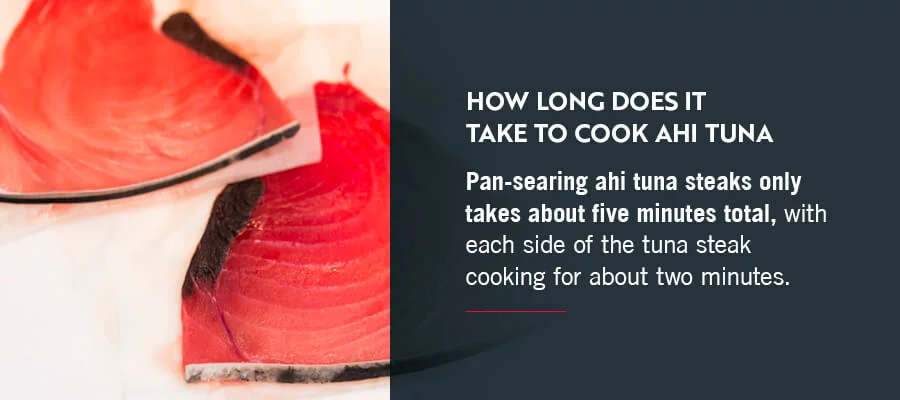
How Long Does It Take to Cook Ahi Tuna
Because ahi tuna is best enjoyed rare or medium-rare, it generally doesn’t take long to cook tuna steaks. In fact, pan-searing ahi tuna steaks only takes about two minutes total, with each side of the tuna steak cooking for about a minute. Try to stick to this timetable because ahi tuna hardens very quickly as it cooks — and you want your tuna steak to be soft and tender, not hard and dry.
Top Ahi Tuna Recipes
While ahi tuna is decadent on its own, you likely want to find a few different ways to prepare it. If you’re looking for some of the best ahi tuna creations you could put on your plate, try one of these top three tuna recipes:
- Polynesian tuna salad: Take classic tuna salad up a notch with this Polynesian tuna salad recipe. Although the recipe calls for regular tuna, substituting in ahi tuna will elevate this recipe to new culinary heights. The smooth texture of ahi tuna will excellently complement the crunch of chopped celery and diced water chestnuts, giving you a tuna salad worthy of a Michelin star.
- Pan-seared ahi tuna steaks: This pan-seared ahi tuna steak recipe packs a flavorful punch. By pairing the perfectly cooked ahi tuna steaks with a savory tamari-ginger dipping sauce, you’ll get a meal that’s quick, easy and stunning.
- Marinated tuna tartare: If you love the natural taste of ahi tuna, this marinated tuna tartare recipe is sure to be your new favorite. The tartare’s delicate marinade is just enough to add a hint of flavor to the tuna while still allowing the fish’s mild flavor to shine through.
Use SAN-J Sauces to Season Your Ahi Tuna
Are you ready to cook a drool-worthy ahi tuna dinner? Make sure your ahi tuna is properly seasoned with help from the wide variety of SAN-J products. From basic soy sauce to flavor-packed cooking sauces, SAN-J has everything you need to whip up an ahi tuna masterpiece. Check out our other recipes using SAN-J sauces!
Use our product locator to find your favorite SAN-J sauce today and get cooking! Contact us with any questions!
Back to Top

